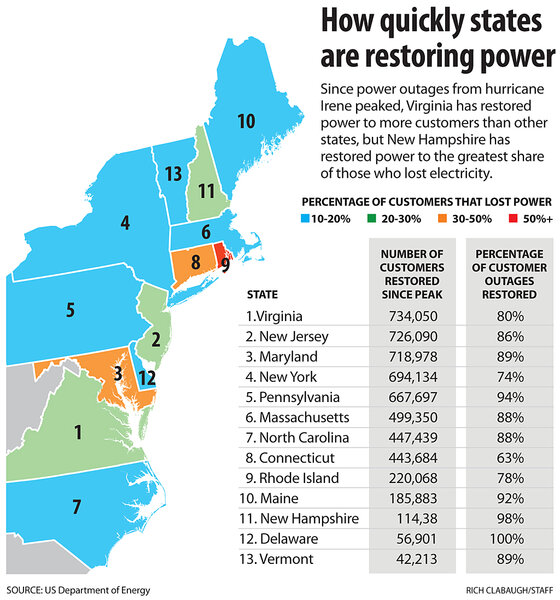Irene aftermath: Which states are restoring power the quickest – and why?
Loading...
| Boston
Utility crews battling fallen trees and flooded rivers have in a four-day span turned the lights back on for 5.6 million customers who had their power knocked out by Hurricane Irene. Some 1.1 million remain waiting in the dark in 12 states.
Despite weakening rapidly, Irene remained a massive beast the size of Texas, whose gusts hammered areas of the East Coast that have not seen a hurricane in many years. In that time tree growth near power lines had not been cut back, contributing to the large number of downed power lines, grid experts say.
But it could have been far worse. Overall, power has been restored with remarkable speed given the magnitude of the outage say emergency-management experts.
With days of advance warning from forecasters, utilities called in thousands of trucks and crews from the Midwest and South, drawing on agreements with brother utilities in states as far away as Colorado and Georgia. In addition, coordination between utilities and government disaster managers was notably good, observers said.
"We're not hearing what we heard after Katrina, about the lack of communication between federal, state and local emergency managers," says Mark Merritt, president of Witt Associates, a Washington consulting firm that conducts post-hurricane response analyses for governments. "What we're hearing – and it is nonpartisan with independent mayors, governors – is that the response is as good as its ever been and as good as it probably could have been."
Since the peak impact on Sunday, utility crews have restored power to nearly 1.4 million customers per day across all 13 states and the District of Columbia, according to data collected by the US Department of Energy (DOE). By Thursday morning, the District of Columbia and Delaware both were reporting all customers' power had been restored.
But some states were harder hit than others and showed varying rates of recovery, the DOE data shows (see graphic).
The hardest-hit states by percentage of customers who lost power were Rhode Island with nearly two-thirds of all its customers losing electricity, followed by Connecticut with nearly half its customers, and Maryland with about one-third.
Maryland has bounced back quickly, restoring power to 90 percent of its customers that lost electricity. For Rhode Island, the figure is 78 percent.
But severe flooding has hampered power restoration in Connecticut. At one point it had 702,000 customers who lost power. It still has 258,470 customers in the dark.
Connecticut's performance, however, is much better when measured by the number of customers restored each day. It has restored nearly 111,000 on average since Sunday –about middle of the pack – despite flooding.
Virginia led states with power restored to 183,000 customers each day on average, followed by New Jersey, Maryland, and New York.
Still, no data are ultimately adequate to measure the performance of utilities in responding to the emergency, experts say.
"The numbers don't tell the whole story," Mr. Merritt says. "Rhode Island just doesn't have nearly the river flooding that faces Connecticut, and that flooding has a big impact because crews can't reach where the customers are. The bottom line is that all of these states are restoring power at double digit rates – they're all doing pretty well."
Others, however, say power might have come on a bit faster if prediction tools are fine tuned. Scientists at Johns Hopkins University in Baltimore have developed forecast models that take into account myriad elements that cause poles or trees to topple, including wind speeds, soil moisture, topography, and land use.
Their forecasts for Irene suggested that utilities in Maryland were likely to face about 500,000 outages. The utilities planned for 100,000. The actual number ended up being 807,000.
"If they had worked from [our forecast], they would have been better prepared,” Seth Guikema, assistant professor of environmental engineering at Johns Hopkins, said in a recent Monitor article. We think we have something utilities will be able to use going forward."
Still, residents in the dark wonder why their lights aren't on – when their neighbor’s in another part of town are. Much of that – flooded areas notwithstanding – has to do with prioritizing which systems to switch back on first.
After a big storm like Irene, the first priority is to restore failed transmission lines and substations, because local networks supplying power to customers do not function otherwise. Next priorities are power to emergency services such as hospitals, police, fire stations, and emergency call centers. Next come critical infrastructure like telecommunications and water followed by fixing downed live wires and other dangers. Last on the list are distribution feeder lines that supply the largest number of customers.






